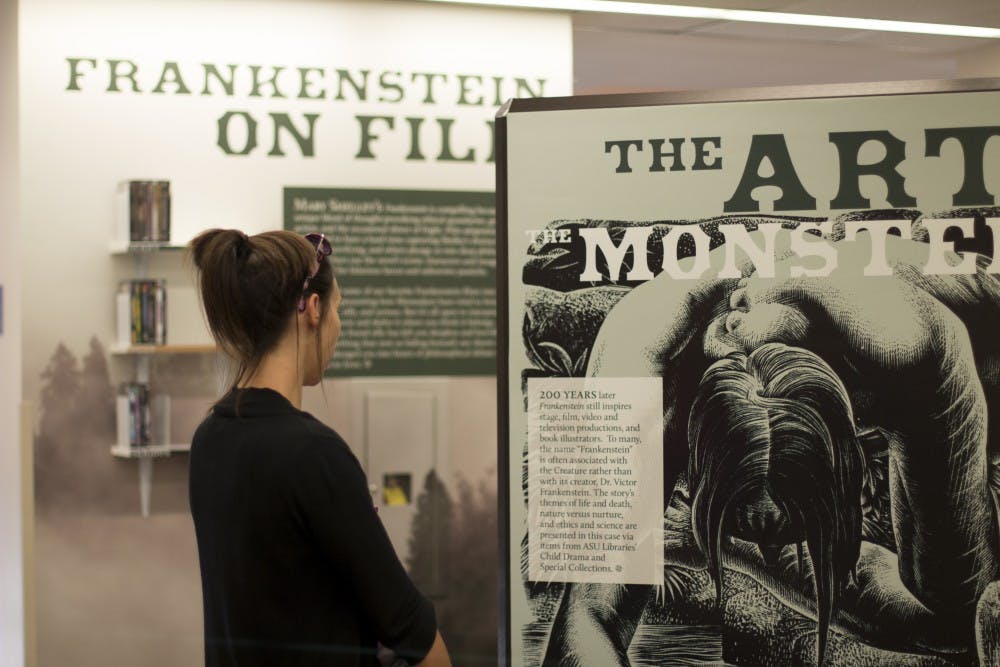Frankenstein at 200 brings to life an interdisciplinary creation that explores the history of "Frankenstein," what makes it so compelling and why it matters today.
The exhibit is produced by ASU faculty and students along with several members of the community. Beside the historical perspectives, there are several works from artists with their personal interpretations and experiences with the story.
Frankenstein at 200 looks at several different perspectives. Experts from all over the University, including the Center of Science and Imagination, the Herberger Institute for the Design and Arts and the Department of English, worked together to create this exhibit.
Bob Beard, the communication and public engagement strategist at the Center for Science and the Imagination, said that the exhibit is honoring the history behind the story that was developed long ago while analyzing its relevance in today’s society.
“We are grappling with the technology that challenges our perspectives of what life is and what it means to be a creator,” Beard said. “These are things that we are dealing with right now, so 'Frankenstein' is amazingly relevant 200 years after it was published.”
The story of 'Frankenstein' dates back to 1816, when Marry Shelly created what was and still is considered the first science fiction story. It questions the power of creation through the technology of the time, which can be paralleled with the creations based on the technology of today.
Beard described one piece by ASU School of Art alumnus and faculty associate Bobby Zokaites, who used the technology of today to create a painting robot as part of the exhibit, as adding another component to the function of Frankenstein at 200.
“The whole exhibit questions whether certain things created can be considered life,” Beard said. “There’s a case that can be made for that— even if it’s not traditionally alive.”
Zokaites transformed a Roomba to become a painter by stripping down its parts and transforming its function into something else entirely. He spent hours preparing this machine to do the painting, which is typically the artists’ expression, causing him to face the question of whether he was the artist or if the robot was.
Assistant University Librarian Jennifer Duvernay said she is excited to see the collaboration of the library with different departments throughout the University and expose the work to a large audience, especially ASU.
“I think it’s important within the university setting to explore ideas in different ways,” she said. “We wanted to highlight all of the different inspirational stories and issues this one seemingly discreet piece of literature (Frankenstein) inspired.”
Duvernay said with the exhibit being in Hayden Library, students can come upon it by pure happenstance, like somebody coming to study or pick up a book. The library is right in the heart of Tempe campus, which receives foot traffic from students and faculty alike.
“I personally think it’s the best exhibit that has ever been on display in the ASU libraries, and I’ve worked here for 16 years,” Duvernay said. “It’s the combination of the content and imagination.”
Another artistic piece explores the question, "Is it alive?" Artist and non-degree graduate student Karla Elling created pieces of paper from scratch with writing on it that listed things that could be alive, like kombucha, a fermented sweet tea, or even a hashtag.
Elling said that she had not read "Frankenstein" since grad school and revisited the story for the exhibit. She collaborated with a few other artists to explore what creations can be considered alive based on today’s society and technology.
“That, of course, is the whole issue of this study of 'Frankenstein' and what is the power of creation,” Elling said. “This particular exhibit brings a whole new attitude to the library, getting back to what it was. The library is coming alive again.”
The Frankenstein at 200 exhibit will remain in The Hayden Library through December 2016.
Correction: Due to a reporting error, a previous version of the story incorrectly stated that Bobby Zokaites is a professor at ASU. The article has since been updated to reflect his position accurately.
Reach the arts reporter at alexandra.k.myers@asu.edu or follow @akmyers2asu on Twitter.
Like The State Press on Facebook and follow @statepress on Twitter.




